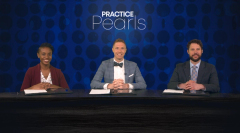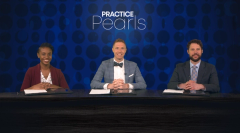
Importance of Patient Education In MPN Treatment
Experts in MPN care discuss the importance and impact of patient education while managing myeloproliferative neoplasms.
Episodes in this series

Ryan Haumschild, PharmD, MS, MBA: Sharita, I have a question for you. As we think about the community setting as well, how do you treat and monitor your patients over time? Are there any unique measures of success that you’re looking at to say, “This patient is fine, they’re doing well on therapy,” or that they may not be doing as well with this metric, and it might be time to look at another therapy?
Sharita Howe, PharmD: I’m going to echo what Jeff said. We’re bringing our patients in about every 3 months and assessing them using laboratory monitoring. We’re getting a CBC [complete blood count] on these patients. We’re assessing them for splenomegaly, whether we’re palpating or using radiologic tests to measure spleen size. We’re also looking at patient-reported symptoms and using other risk stratification tools to assess these patients. We’re able to discover if their disease is stable by looking at these 4 different aspects. When we look at these different aspects, we can see whether the patients are stable, progressing, or have transformation, or if we need to do something different for them. It’s standardized, even though this disease isn’t standard by any means. But when we look at that, we’re able to get a clear picture of what’s going on in these patients.
Ryan Haumschild, PharmD, MS, MBA: Part of the patient care journey is education. When patients are educated, they know what to expect, are less likely to be resistant, and might recognize the subsequent therapy. If you have to make any dose adjustments, they aren’t afraid to tell you if they’re having adverse effects because they know it might be a normal part of their journey. Sharita, when you’re educating patients, how do you develop this education? How do you set it up? Is it standardized? What tools do you use to leverage education with the patient?
Sharita Howe, PharmD: We do a lot of education with our patients. We’re seeing patients at multiple levels and doing patient education at multiple levels. When a patient is diagnosed, they get that initial visit with the physician where the physician is telling them about their disease state and treatment options. At the end of that visit, they’re receiving paperwork. We use oral chemotherapy education sheets or IV [intravenous] cancer education sheets, which are both online.
Those educational sheets are available. They were a collaboration between NCODA [National Community Oncology Dispensing Association], ONS [Oncology Nursing Society], ACCC [Association of Community Cancer Centers], and HOPA [Hematology/Oncology Pharmacy Association]. They developed these educational tools. I like to use them because they make education easier by the time we get down to the pharmacy level. On one side of these sheets, it’s showing the patients what they can expect from the treatment, and in the next column, it’s showing them some things that they can do to help mitigate some of these symptoms that they may experience while on treatment.
They’re getting education at the physician level. They’re also getting education with the APPs [advanced practice providers] when they see them for consent. Then when I talk to them in the pharmacy, they’re getting education at that level.
Typically, when I give education at the pharmacy level, it’s more patient-specific. We have already looked at drug interactions or other conditions that the patient may have that could put them at risk for certain adverse effects or symptoms. We’re educating in a patient-specific format, letting them know what we discovered from doing their chart review and then getting the patient involved with what the plan is from that side of things. We also realize at the pharmacy level that patients will have different questions. The patients go home, find out about their disease, and then the first thing they do is go to Google and ask Google questions that they probably should ask us in the clinic.
We’re able to answer some of those questions for the patient. Depending on the types of questions the patients ask, we’re able to give them a tailored education experience. I have some patients who come to me with the studies and are asking about overall survival or progression-free survival. We have to go into what that means for the patients. I have some patients who ask me about specific adverse effects, so then I talk about the numbers or percentages. I say, “When we look at this adverse effect and we look at a study, the study incorporates grades 1 to 4, so we’re talking about a percentage of something that you may only have at a grade 1 or you may not have at all.”
We start to have those discussions with the patients. But I like the education sheets specifically because they help break that down for the patients in a way that they’re able to digest, and the pharmacy team adds on top of that with any patient-specific monitoring or questions that they may have.
Ryan Haumschild, PharmD, MS, MBA: You’re right. We’re having a much more educated patient coming into the clinic nowadays. There are so many resources at their fingertips that even if it’s an institution-specific webpage describing the disease and treatment options, or they’re Googling and looking into some of the studies based on their educational background, it’s great. The more information we can put out there, the better. But like you said, it doesn’t change our responsibility of creating that layered level of education, meaning first appointment, subsidiary appointments, and then even offering resources outside of the clinic appointment so that the patients have something to review when they get home.
Jeff, I don’t know how you approach it, but I’d be interested to hear your organization’s approach and your clinic-specific approach in how you’re educating the unique patient population with MPNs [myeloproliferative neoplasms].
Jeff A. Gilreath, PharmD: I completely echo what Sharita said. We’ve had numerous patients go home and go online and find out that Hydrea [hydroxyurea] “causes” AML [acute myeloid leukemia], and then come back to the clinic and refuse to take the therapy that we recommended to treat their MPN. We took matters into our own hands, in that I partnered with a number of pharmacists at academic centers throughout the United States to create our own patient education resource called ChemoExperts.com. We built this resource from the ground up to educate patients in the way we as pharmacists wanted to be educated. Knowing that people will go home and search the internet for information, we wanted to meet those patients where they were, so we became search engine optimization experts and modified our material so that it could be found by patients.
To date, we have had well over a million patient users of our website globally, so we’re very proud of that. We provide education on all sorts of cancer types, including MPNs. To Sharita’s point, we pride ourselves on providing evidence-based recommendations, literature, and standardization. We walk through what it is, the goal of care, how the medication works, and what the schedule is. The adverse effects section is taken from the landmark trials used to gain FDA approval.
When combination regimens are used, we take the adverse effects from those clinical trials so that we give a better portrayal of what that patient can expect, rather than piecemealing drugs out in a singular fashion and taking adverse effects from other disease states. For example, hydroxyurea might be used for sickle cell anemia, thalassemia, or a variety of other disorders or diseases, and these adverse effects make it into some of this patient education that isn’t pertinent to a patient with MPN taking Hydrea. By using the clinical trials and teasing out those adverse effects, it’s more relevant information.
We also introduced what we call ChemoExperts Tips, which are clinical pearls that we have gleaned from our own personal experience taking care of patients. By doing this, we’re giving patients the evidence that they need and providing it at a depth at which they can go in and educate themselves as much as they want to. With a couple of clicks, they have access to that clinical trial available in PubMed. Or if they’re searching for adverse effects, they’re able to get that information.
We recently submitted an abstract to ASCO [American Society of Clinical Oncology] last year asking patients what they wanted, and a lot of it was focused on adverse effects. People want to know the onset and duration, and a lot of times this isn’t reported in the clinical trials, like Sharita mentioned. We’re hopeful that one day these studies can incorporate some of these more granular data to help patients, because that’s what they want to know.
Transcript edited for clarity.
Newsletter
Stay informed on drug updates, treatment guidelines, and pharmacy practice trends—subscribe to Pharmacy Times for weekly clinical insights.












































































































































































































